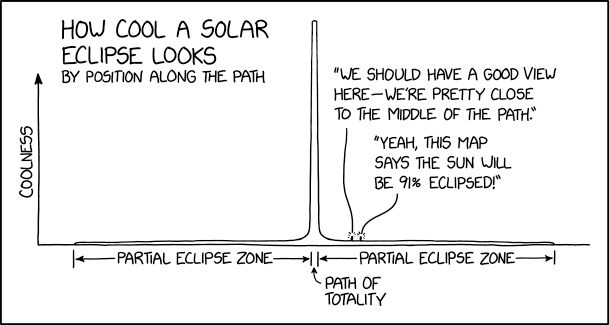Eclipse Coolness

A partial eclipse is like a cool sunset. A total eclipse is like someone broke the sky.

A partial eclipse is like a cool sunset. A total eclipse is like someone broke the sky.
A total solar eclipse occurred in North America on April 8, 2024, a week after this comic. A solar eclipse occurs when the Moon moves between the Sun and the Earth, but in order for it to be a total eclipse, the Sun, Moon and the observer's position on the Earth need to line up nearly exactly, and at the right distances (if the Moon is too far away, the eclipse will be annular, rather than total). When such a phenomenon occurs, there's a "path of totality", referring to the range of locations where such an alignment occurs (though only for a few minutes in each location). Away from, but near to, the path of totality (and outside of the specific time of totality), the Moon partially obscures the Sun. In Boston, where Randall lives, the Sun will be 93% obscured at the local peak of the eclipse.
The comic refers to the fact that the human eye is very good at adapting to different levels of light intensity. At 95% occlusion, it's noticeably dimmer outside, but the effect is similar to light in late evening, or on a heavily overcast day, nothing particularly remarkable. Using eclipse glasses (or a simple pinhole camera), it's possible to see the Sun being occluded, but someone unaware that an eclipse was occurring would barely notice that anything was happening.
Within the path of totality, it's a different situation. Though an eclipse for any given locale could be experienced at all times from dawn to dusk, the most dramatic ones will occur somewhere around the middle of the observer's day. When the Moon fully obscures the Sun, for a brief period of time, the area becomes almost fully dark without the usual or expected crepuscular transition. Temperatures drop noticeably in a matter of minutes and wildlife (and people) may react in unusual ways. The level of light in the rest of the sky is similar to that which accompanies a sunset, but in all directions and without the horizon's red light effect. Most dramatically, the previously unseeable Sun's upper atmosphere can be viewed, as a ring around the dark circle of the Moon, with the naked eye (which should only be possible once the bright solar disc is obscured, and until it starts to appear again). At the very limits of totality, though perhaps most dramatic at its ending, the smallest sections of the bright solar surface will briefly be the only parts to shine through low points on the Moon's edge to form Baily's beads, or a "diamond ring" effect, not at all visible beyond the narrow central strip of the eclipse.
The graph in this strip points out that the difference between 91% (or even a 99%) eclipse and a total eclipse is dramatic. An almost total eclipse is barely noticeable, while a total eclipse is a visual phenomenon unlike any other. This is a situation where being close to the path of totality and being on it makes a huge difference.
Forbes made a similar reference to total solar eclipses being only worthwhile seeing if in the direct path of 100% totality, with a "map of nope". The map shows all of North America that's not directly in the 100% path of totality as "Nope/Nada" meaning that anyone in those areas won't experience the full "OMG!" experience of the total solar eclipse. The article mentions hotels may claim to be close enough to the eclipse with "nonsensical oxymorons like '99% coverage of the full total eclipse'" and that it is common for people to think: "I'm happy to avoid the traffic and settle for 95%'".
The title text simply emphasises the point of the comic - the significant difference between a partial and a total eclipse. It is unclear whether the claim is that a partial eclipse is really 'like' a sunset, while a total eclipse seems like someone broke the sky — claims which would be hyperbolic — or if the intention is to say that the comparison between a partial and total eclipse is equivalent to the comparison between a cool sunset and a broken sky.
Randall has earlier made many comics about the 2017 total solar eclipse, such as 1876: Eclipse Searches through 1880: Eclipse Review and 2816: Types of Solar Eclipse. Randall and his wife also made plans to see the 2024 eclipse in 1928: Seven Years.
Additionally, the graph appears similar to a Dirac delta distribution.